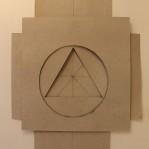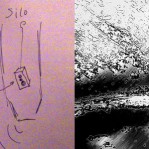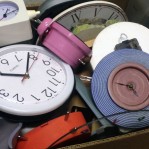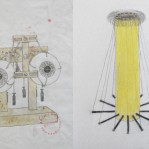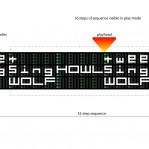The monstrous idea of the Diamond Planet (“55 Cancri e”)
By Åsa Maria Bengtsson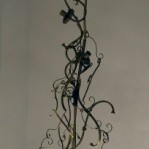 The 9 m high chandelier is made of light, brass and crystal. It makes shadows on the surrounding walls.
The 9 m high chandelier is made of light, brass and crystal. It makes shadows on the surrounding walls.
The work is about energy of course. We are using so much of it, that it decreases constantly. The consequence is that we have to find other places to explore. In that sense it also says something about the countryside versus the city, how people move to where they think they´ll find the greatest opportunities, the diamonds. The mill used to be a place for producing energy (food) and has now lost that purpose.
Installation:
The chandelier hangs from the ceiling on a chain and hangs down 9 m. The electric cord follows the chain upwards and is connected to the electricity (220V) at the end.
Bio:
Born in 1956, grew up in Östersund. Lives and works in Malmö. Educated at the School Graphics Forum in Malmö 1982-1987. Works in many different techniques, video/film, sound, photography, sculpture, lighting, installations and public works. In her art, she deals with themes concerning nature, the environment and human identity.
Moulin Verte
By Christina Bredahl & Lena Ignestam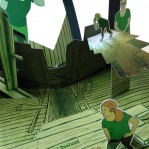 For the exhibition, we want to present a larger joint contextual work-Moulin Verte (The Green Mill) – a 3-dimensional drawing in motion, made in pop-up technique.
For the exhibition, we want to present a larger joint contextual work-Moulin Verte (The Green Mill) – a 3-dimensional drawing in motion, made in pop-up technique.
Based on the Mill and related to the exhibition title, we imagine creating a folded conceptual miniature model of The Mill, its elements and the surroundings . When the work is activated (played) by the spectator, it unfolds as an accordion, and a distinct sounds recorded on site, emerges in a new form as soundsampling, as a melody coming from within the 3d drawing.
We will also participate with a limited edition of multipels, Moulin Verte -popupcards with sounds for the shop.
Installation:
The piece is installed on in a larger monter/ table, with hidden mechanics, speakers and software inside. Our help with the technique Erik Pilesjö works with special effects at Malmö Opera Studios.
We will go to the Mill soon, to collect all the necessary information and recordings, and to do sketches, to build our piece.The size of the Moulin Verte when its open is A2 + surronding table.
We send example on earlier popup-works, see also our websites.
Examples:
http://lenaignestam.com/wp-content/uploads/2013/02/brygga-kopia.mov
http://www.bredahlduelund.com/works/lake.php
http://www.danskegrafikere.dk/index.php?n=Udstillinger2012.ChristinaDuelundVSLenaIgnestam
Bio:
We are two artists, Lena Ignestam (SE) and Christina Bredahl Duelund (DK), both working with animation, drawing and sculpture. We have done a number of collaborations together. For some time we have been working with the idea of the folding,and have done a series of works in 3d-pop up technique.
lenaignestam.com & bredahlduelund.com
South by Southwest
By Jack Toolin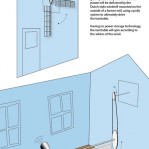 A wind driven windmill that drives a record player playing a record.
A wind driven windmill that drives a record player playing a record.
Installation:
A windmill or pinwheel (yet to be decided) mounted on the exterior of the building; a shaft running through an opening (window?); record player platter on a tabletop; the platter driven by belt or gear; the sound amplified by a megaphone (Gramophone-like bell structure). The record(s) being played are yet to be decided.
Bio:
Jack Toolin works with a variety of media to investigate and comment upon the relationships between individuals and social systems. His work in photography, new media and performance has been presented nationally and internationally.
The eye of the pendulum
By Monix Sjölin & Robert Ek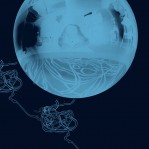 Foucault pendulum in the shaft with a camera as the eye. The output will be a computer screen, a tv-set, a projector or whatever is suitable.
Foucault pendulum in the shaft with a camera as the eye. The output will be a computer screen, a tv-set, a projector or whatever is suitable.
Installation: A long string with a heavy metal or wooden ball attached to it. A camera in the middle of heavy ball outputs to a suitable display. The floor, registered by the camera, might be painted.
Bio:
Monix Sjölin is an artist from Malmö. She’s graduated from the art academy in Trondheim.
Robert Ek is an artist from Malmö.
bekant.org + monixikonsten.blogspot.
HTMLinstrument
By Ursula Endlicher HTMLinstrument is an Internet art piece that uses the HTML code of the Triennial’s Website – instrument.
HTMLinstrument is an Internet art piece that uses the HTML code of the Triennial’s Website – instrument.
Contemplative, playful, and slightly absurd, HTMLinstrument invites the audience to pluck a virtual wooden string instrument, which changes shape for different HTML tags that appear in the source code of the exhibit’s Website.
HTML tags such as HTML, HEAD, or META are “tuned” in German music notation of C-D-E-F-G-A-H-C, using these keys for interpreting individual letters of the tags. Letters that are not covered within this scale are translated into different themes.
Inspired by the wooden and spatial structure built for its (former) functionality as a flour mill, HTMLinstrument consists of a variety of virtual wooden shapes and tunes representing HTML tags and their different functions on the Web.
Installation:
HTMLinstrument is embedded within the mill’s walls; round openings in the wall show the monitor (that displays the “instrument”) and the speakers. The instrument will be played using a wooden mouse. HTMLinstrument needs an Internet connection.
Bio:
Ursula Endlicher’s work resides on the intersection of Internet, performance and multi-media installation. She translates the structural components of code and networks into choreographies for performances, installations and objects. Her work is shown internationally, most recently on Whitney.org, with Streaming Museum, at ZERO1 Biennial, at ISEA, and at Transmediale; and previously at SIGGRAPH, Postmasters Gallery, and at CCA Ujazdowski Castle. Born in Vienna, she lives in New York since two decades.
Instrument – Teckninga
By Gertrud AlfredssonMitt verk är en Artist Book, Ett originalverk som relaterar till platsen Lövestad Kvarn och mig som person.
Installation:
Min “artist book” INSTRUMENT handlar om min hand, tanke och känslan för innehållet, om ett fenomen och en metafor. Har valt ordet och skriften som ett tillägg till bilden. Min tanke är att ordet/ texten är själva bilden och bilden är något helt annat. Min utgångspunkt är: Kvarn, stege, smärta, damm, ekonomi.
Bio:
Gertrud Alfredsson (S) arbetar med teckning, måleri och installation med focus på identitet. Mitt intresse ligger i att skapa nya verk av gamla händelser för att återspegla processer och att undersöka vad som händer över tid. På så sätt skapa nya världar. Museum Jag är ett sådant projekt där jag gav mig själv som konstnär en form av museum, med hjälp av konstverk och projekt i historiskt perspektiv. Nu är mitt intresse att använda mig av den idén men binda den samman med framtid, nuet och platsen.
Ever, At All
By Christopher Evan YoungMy father was born in Quakertown, Pennsylvania in 1954. As he grew older he developed a passion for the guitar. It wasn’t long before he was regularly touring the bars and clubs on the East Coast playing music. While in his early 20s he was called to New York City to Polygram Records (The Who, Rush, Cream, Black Sabbath, Jon Bon Jovi) to discuss the possibility of a career in the music industry. He left New York that day never to pursue the opportunity further.
This work explores the relationship between the past and the present, in a continuous battle for precedence. As my father’s memories come flooding back during the retelling of his story, they are built and layered upon using forgotten technology. As each memory is formed and added to the next in a tangled assortment of experience, they slowly fade into and are consumed by the present.
Installation:
The untouched audio of an interview with my father, recounting this story, is fed into one reel-to-reel player, it is there recorded to tape and then transferred to a second player. When the second reel-to-reel plays what was just recorded, that audio is fed back to the first reel-to-reel machine. Microphones are positioned to pick up ambient noise and add it to the loop. This creates not only a repeating loop, but one that is organic and grows differently with each cycle. Speakers placed on the floor project sound upward allowing it to reverberate off the walls of the space. The acoustics of the room play a large factor in the sound that is produced, transforming it into that of an instrument. This allows the room to become an active participant in the final sound that is heard.
Bio:
1990
Quakertown,PA
Growing up and fully experiencing the transition from analog to digital during my development, I equate many obsolete technologies with my childhood. I explore the relationship of these forgotten devices with the present in order to better understand where we came from and where we are going.
spiral columns
By Kazue Taguchi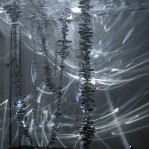 Currently I make my work by using reflective material and light. When light hits the surface, a complex interplay of reflections and shadows are created. Light is intangible and invisible, but its effect on our lives is profound. My interest in creating works with light is in experiencing the phenomenon of their visual qualities as well as in the creation of a relaxing and sublime space.
Currently I make my work by using reflective material and light. When light hits the surface, a complex interplay of reflections and shadows are created. Light is intangible and invisible, but its effect on our lives is profound. My interest in creating works with light is in experiencing the phenomenon of their visual qualities as well as in the creation of a relaxing and sublime space.
Installation:
This silver object is made out of Mylar: Silver plastic film which is very light.
The objects were hang from the ceiling and
a few LED spot lights are placed on the floor.
Bio:
Kazue Taguchi was born in Japan, lives and works in New York. She received her M.F.A with a concentration on glass in 2007 from Virginia Commonwealth University. Solo exhibitions include; Kunst Palast Museum-Glasmuseum Hentrich, Düsseldorf, the Alcorcon Glass Museum in Madrid, and lorsh+seidel Galerie in Berlin.
I hear You Dear Mölla
By Bent Bøgedal Christoffersen
Sounds collected from Kulturmöllan will be processed in a computer and used as an Instrument played Live . The collection is an ongoing process and will change during the time of the exhibition and the content and spirit off the Work itself will be improvised and as spontaneous as possible, trying to catch the atmosphere and mood of the Dear Mölla.
Installation:
As the work progresses there might be pictures, video art and I might find an instrument in the pile of junk in the Kulturmölla.
Bio:
Contemporary Sound Artist, Musician, Composer, Soundpainter and Sculptor.
Graduated from Fröbel Highschool 1975 as a social educator with Drama as my main subject, I am a child and family Therapist graduated from the Martin Krichenbaum Institute.
My focus right now is experimental electronic and improvised Soundart and Live Performence and Soundpainting.
Almost Everywhere
By Wes Heiss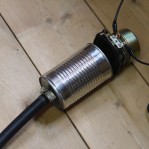 Using the antiquated technology of ‘speaking tubes’ this piece playfully collapses the mill’s interior and exterior soundscapes.
Using the antiquated technology of ‘speaking tubes’ this piece playfully collapses the mill’s interior and exterior soundscapes.
Installation:
Almost Everywhere consists of a network of tubes routed through existing interior and exterior holes left by previous renovations to the mill. These tubes gather at one end in a listening station located outside the building and at the other end distributed near sound installations inside the mill. Tin cans attached to the ends of the tubes allow you to put your ear up to the piece and hear a selection of artworks in real time.
Bio:
Wes Heiss is a visual artist and designer whose work explores humanities relationship with technology. He teaches Product design at Lehigh University, has a collaborative public art practice with Marek Walczak, and exhibits work internationally. He has won an Artadia grant, a PCA Grant, and residencies at the MacDowell Colony, Skowhegan, Roswell AiR, and the Bemis Center.
Silence and Sound
By Christine Gedeon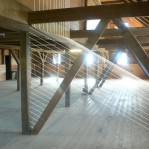 Using a combination of strings and various playable wire, I’d like to incorporate the architecture of the mill to create a hybrid of silence and sounds.
Using a combination of strings and various playable wire, I’d like to incorporate the architecture of the mill to create a hybrid of silence and sounds.
Installation:
I will use nails, string and wire to create parallel lines resembling an instrument. I hope to have this playable using a pick up. If not, it will stand on it’s own as an instrument of silence.
Bio:
Christine Gedeon was born in Aleppo, Syria and lives between NYC and Berlin. She examines the spaces we live in and how it affects us as individuals, using thread mainly as a medium, as both installation and works on canvas. Her installation work resides on the merging of the architectural space and the work itself.
Function Time
By Rory Solomon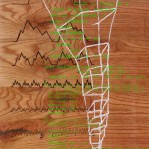 The function call stack will be recorded and charted for one millisecond for twelve popular open source software systems. These charts will be converted into musical notes creating a score. The millisecond will be expanded to a 15 second duration and looped, getting shorter and shorter each play, until finally the individual notes meld into one steady hum. Algorithmic or program time will be auralized on a human scale, and then the viewer will gradually be drawn in to the speed at which computational objects actually function.
The function call stack will be recorded and charted for one millisecond for twelve popular open source software systems. These charts will be converted into musical notes creating a score. The millisecond will be expanded to a 15 second duration and looped, getting shorter and shorter each play, until finally the individual notes meld into one steady hum. Algorithmic or program time will be auralized on a human scale, and then the viewer will gradually be drawn in to the speed at which computational objects actually function.
Installation:
Every hour on the hour, as well as at 15 minute intervals, a different Echo Mesh node will play one of the twelve scores. The piece is intended to evoke the periodicity of clock tower bells, juxtaposing “old” modes of industrial time with the “new” modes of computational media.
Bio:
Rory Solomon is an artist and software developer. He is Tech Lead for the Urban Research Tool: a mapping platform for geo-spatial research at the New School. He has collaborated on projects featured in the Whitney Biennial and the National Art Museum of China. He currently teaches programming at Parsons.
One Liner
By Maria Westerståhl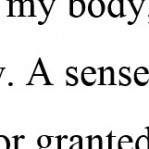 The One Liner is a single line of text applied to the interior surfaces of the mill like Ariadne’s thread through a labyrinth. The text is an amalgamated narrative of a temporary artistic community, based on a dialogue with individuals about the nature and process of their work. The piece invites the reader / visitor to follow a thread through the imagined internal consciousness of a temporary collective identity as well as the spaces it inhabits, imposing a format of unity to engage with the paradoxical dynamics of authorship, creativity and identity.
The One Liner is a single line of text applied to the interior surfaces of the mill like Ariadne’s thread through a labyrinth. The text is an amalgamated narrative of a temporary artistic community, based on a dialogue with individuals about the nature and process of their work. The piece invites the reader / visitor to follow a thread through the imagined internal consciousness of a temporary collective identity as well as the spaces it inhabits, imposing a format of unity to engage with the paradoxical dynamics of authorship, creativity and identity.
Installation:
Text printed on adhesive vinyl strips cut into 5m lengths and numbered for sequential installation on clean wall / ceiling surfaces. Will propose a plan layout but this can be easily adapted on site.
Bio:
Maria is an architect working with school and community projects in the UK, with an extracurricular interest in exploring spaces through text.
Basongs
By Ludvig Åman & Magnus ÅmanMagnus and Ludvig (father and son) plays the roles of engineer and musician to give the silos voices of depths, creating a subtle dialog, with the help of microelectronics and sound programming.
(The piece will be recorded to MP3 as soon as it is ready, and submitted)
Installation:
Each silo is fitted with a free floating 80 litre loudspeaker with 12″ bass elements, hanging from a wire, driven by two audio channels coming from an amplified signal source – a microcontroller that generates sinusoidal bass tones in temporal patterns conceived to impersonate giants swimming in the deep.
Bio:
Magnus, electronics engineer with past in exhibition of neon tube artwork. Principle interest is in music that is shared with his son Ludvig.
THE SONG OF THE MILL
By Kine Lillestrøm & Trond Hugo HaugenKine and Trond Hugo have collected clocks from around Lövestad. Posters have been put up in nearby shops and cafes, asking people to contribute with their time: old ones, new ones, good ones, and funny ones. Time is a constant subject: it never goes out of time.
Clocks as sound.
Sound as instrument.
Instrument as structure.
Structure as time.
Installation:
The artists will make an installation / piece of the clocks at site.
Bio:
Kine Lillestrøm: Born in 1977, grew up in Alvdal, Norway. She lives and works in Oslo with site-specific projects and spatial structures.
Trond Hugo Haugen: Born in 1975, grew up in Stavanger. He lives and works in Oslo with drawings, books and social/historical/political projects.
kinelillestrom.com & trondhugo.no
Sponsored by:

CORRESPONDENCE Machinations – Thingumajig
By Jan Bäcklund & Katja SerberThis group of drawings is produced in a kind of visual dialogue between some of Katja Serber’s thingumajig-drawings and Jan Bäcklund’s bureaugraphic form. In the Thingumajig series, which is an open-ended series of drawings begun several years ago, Katja Serber places drawings, which, when finished, seem to depict utensils that she don’t know, don’t remember, or doesn’t wish to call anything. She looks upon them as scientific or religious utensils from the past, future, or from another reality. The machinations, on the other hand, are produced as the conceptual products of a ficticious J.W. Müller’s Maschinenfabrik, they depict an archive of fragmentary machine parts with biomorphic functions and is issued by Jan Bäcklund’s archive.
Installation:
1. Katja Serber: At the exhibition people will be invited to define what the Thingumaji’s instruments are for, by interview, discussions, performances or writing.
2. Jan Bäcklund: On a table is placed a chair, a bunch of blank cards, a cardboard box, a pen, and the appropriate stamps. The audience is thus invited to produce their own drawings, which, if properly filled in, will be included in the archive.
Bio:
Katja Serber, born 1968, sculptor, painter and installation artist.
Jan Bäcklund, born 1966, bureaugrapher.
Serber and Bäcklund lives together in Copenhagen.
Katja: emthy.dk and kunstdk.dk/kunstner/katja_serber
Jan Bäcklund : portheim.org
in-form-a-tion
By Frank GurdakThe architect as bricolor on site and his continuous project altered daily is described to mis-in-form and reads something like this: The piece(s) is the instrument to stimulate a recipient(s) (the viewer/listener) to affect the artists (the maker of the piece) next move. It is a matter of tuning the instrument rather than playing it. The Piece(s) is a diagram, sculpture, representation that is developed through the artists current state of mind.
Installation:
the instrument only need to follow these rules:
1)It is constructed by the artist on site as a performance.
2)It is made with consideration of location, time, space and availability.
Bio:
From: New Jersey
Studied: Architecture at New Jersey Institute of technology
Graduate of Architectural Design at The Bartlett, University College London.
Work: Architectural draftsman, Construction
Hobby: Sailing
http://project.frankgurdak.com/
PlayHead
By Carl SkeltonAn architectural-scale music sequencer that runs on three simultaneous text feeds in real time. Playhead does not care AT ALL about “content”, only patterns and coincidences of timing. Viewers may interrupt the automatic feeds with their own text inputs, but may take quite a while to get control of the sound effects they precipitate.
Installation:
One or more walls are filled by a projector, the text feeds sweeping past a cursor at variable speed; synths associated with each row are triggered as they pass the “playhead” in the center. The font is designed to provide for random combinations of one and three spaces, and glyphs three, five, and seven beats long, thus developing a stochastic composition in 4/4 time ad infinitum. The three default text streams are laments on industrial buildings becoming picturesque.
Bio:
Founder Brooklyn Experimental Media Center and Integrated Digital Media Programs at NYU-Polytechnic; Co-founder Gotham Innovation greenhouse; lead, Betaville; 2012 jane Jacobs Medal for Technology and Innovation; multimedia in the public realm.
Thumpers
By Arne Groh
4 devices with a knock sensor and a knocking actuator that knocks on the surface where the device is located. The devices communicate to each other wirelessly.
They can be put on or under a table, staircase, ground (preferred wood) in separated rooms in the mill.
Installation:
When someone knocks a short rhythm on the surface near one device, it will record this sequence and transmit it to the others. If somebody in the other room hear the sequence and repeats this sequence knocking, a 1 to 1 connection will be established and the two communication members will be able to communicate knocking without seeing who is the partner.
Bio:
1962
Living and working in Kassel, Germany
Making energy-art: with high voltage, incredible loud sound, flamethrowers or smoke
The Spirit of the Beehive 2
By Luke Lowings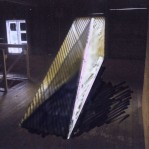 An instrument to precisely register the sensation of the passage of time through the use of daylight and space. A revision of an installation inaugurated three years ago at Kulturmollan.
An instrument to precisely register the sensation of the passage of time through the use of daylight and space. A revision of an installation inaugurated three years ago at Kulturmollan.
Installation:
Translucent plastic, heat reflective film, reflective tape, wire, assembled round the third floor window on the west side of the mill.
Bio:
Luke Lowings has worked between architecture and art for twenty years using daylight to create elements in buildings to enhance awareness of light and time. Luke studied at the Royal College of Art in London and spent 1989-2001 in New York. Luke has run the studio Carpenter/Lowings A & D in London since 2001.
Inside the Mill
By Angela Fraleigh & Johanna Kindvall & Marek Walczak & Wes Heiss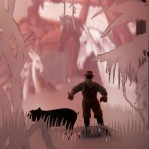 Inside the Mill takes moments in a Swedish Fairy Tale and locates the text inside the walls of the Mill. These frozen set pieces address universal values like greed, avarice and war and relates them to both historical artworks that depict patronage, usury and heroic battles, as well as contemporary icons such as the ATM machine, the 3D printer & drones.
Inside the Mill takes moments in a Swedish Fairy Tale and locates the text inside the walls of the Mill. These frozen set pieces address universal values like greed, avarice and war and relates them to both historical artworks that depict patronage, usury and heroic battles, as well as contemporary icons such as the ATM machine, the 3D printer & drones.
Installation
A selection of optical, analog and digital apparatus are poked through the walls of the mill, revealing different tangents of a universal story, depicted as cutouts, figurines, real-time video and slides.
Bio
Angela Fraleigh is a painter who is interested in how narrative is created, sustained and often idealized.
Johanna Kindvall is an illustrator who likes to tell stories.
Wes Heiss is a visual artist and designer whose work explores humanities relationship with technology.
Marek Walczak is a new media artist creating public and private spectacles merging his interests in architecture and perception.
Recently Marek & Wes completed a public art work in 14th Street, Denver consisting of a series of optical instruments merging past and present views.
Mill drum-kit
By Lars Eklöw I will collect different pieces in different material from the mill, and build a drum-kit. Maybe even the visitors can play on it. I will also play together with my band.
I will collect different pieces in different material from the mill, and build a drum-kit. Maybe even the visitors can play on it. I will also play together with my band.
Installation:
Live music-performance where I play the “Mill drum-kit” together with Random Dice.
Bio:
I´m an artist and musician drumplayer, and the owner of Kulturmöllan.
